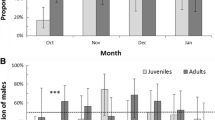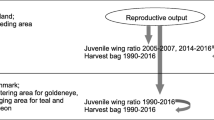Abstract
The proportion of first-year birds in annual wing samples provided by hunters has been used as a measure of breeding success in waterfowl. The proportion of first-year birds in the wing samples of Eurasian wigeon (Mareca penelope) from Denmark and the UK shows a long-term decline, probably reflecting a decrease in breeding success. However, previous studies report conflicting results in the relationship between variation in the proportion of first-year birds and variation in climatic conditions. We used wing data of hunter-shot Eurasian wigeon from Finland to study whether the proportion of first-year birds shows a similar long-term decline and whether between-year variation in the proportion of young is associated with variation in climatic conditions. We found a long-term decline in the proportion of first-year birds. The proportion of young also varied considerably between years, but this variation was not associated with weather or the climatic variables considered for the breeding and wintering periods. More research is needed concerning factors that affect long-term changes and annual variation in the proportion of young in the hunting bag and on the suitability of this index to measure productivity in ducks.

Similar content being viewed by others
References
Alhainen M, Väänänen V-M, Pöysä H, Ermala A (2010) Duck hunting bag in Finland—what do wing samples tell us about the species composition and age structure in a bag? Suomen Riista 56:40–47 in Finnish with English Summary
Alisauskas RT (2002) Arctic climate, spring nutrition, and recruitment in midcontinent lesser snow geese. J Wildl Manag 66:181–183
Arzel C, Dessborn L, Pöysä H, Elmberg J, Nummi P, Sjöberg K (2014) Early springs and breeding performance in two sympatric duck species with different migration strategies. Ibis 156:288–298
Christensen TK, Fox AD (2014) Changes in age- and sex-ratios amongst samples of hunter-shot wings from common duck species in Denmark 1982–2010. Eur J Wildl Res 60:303–312
Clausen KK, Dalby L, Sunde P, Christensen TK, Egelund B, Fox AD (2013) Seasonal variation in Eurasian wigeon Anas penelope sex and age ratios from hunter-based surveys. J Ornithol 154:769–774
Dormann CF, Elith J, Bacher S, Buchmann C, Carl G, Carré G, García Marquéz JR, Gruber B, Lafourcade B, Leitão PJ, Münkemüller T, McClean C, Osborne PE, Reineking B, Schröder B, Skidmore AK, Zurell D, Lautenbach S (2013) Collinearity: a review of methods to deal with it and a simulation study evaluating their performance. Ecography 36:27–46
Elmberg J, Nummi P, Pöysä H, Sjöberg K (2003) Breeding success of sympatric dabbling ducks in relation to population density and food resources. Oikos 100:333–341
Folland CK, Knight J, Linderholm HW, Fereday D, Ineson S, Hurrell JW (2009) The summer North Atlantic Oscillation: past, present, and future. J Clim 22:1082–1103
Fox AD, Kuhlmann Clausen K, Dalby L, Christensen TK, Sunde P (2015) Age-ratio bias among hunter-based surveys of Eurasian Wigeon Anas penelope based on wing vs. field samples. Ibis 157:391–395
Fox AD, Dalby L, Christensen TK, Nagy S, Balsby TJS, Crowe O, Clausen P, Deceuninck B, Devos K, Holt CA, Hornman M, Keller V, Langendoen T, Lehikoinen A, Lorentsen S-H, Molina B, Nilsson L, Stipniece A, Svenning J-C, Wahl J (2016a) Seeking explanations for recent changes in abundance of wintering Eurasian Wigeon (Anas penelope) in northwest Europe. Ornis Fennica 93:12–25
Fox AD, Kuhlmann Clausen K, Dalby L, Christensen TK, Sunde P (2016b) Between-year variations in sex/age ratio bias in hunter wings of EurasianWigeon (Anas penelope) compared to field samples. Ornis Fennica 93:26–30
Freckleton RP (2002) On the misuse of residuals in ecology: regression of residuals vs. multiple regression. J Anim Ecol 71:542–545
Ganter B, Boyd H (2000) A tropical volcano, high predation pressure, and the breeding biology of arctic waterbirds: a circumpolar review of breeding failure in the summer of 1992. Arctic 53:289–305
Gardarsson A, Einarsson A (1997) Numbers and production of Eurasian wigeon in relation to conditions in a breeding area, Lake Myvatn, Iceland. J Anim Ecol 66:439–451
Gebre S, Alfredsen K (2014) Contemporary trends and future changes in freshwater ice conditions: inference from temperature indices. Hydrol Res 45:455–478
Gebre S, Boissy T, Alfredsen K (2014) Sensitivity of lake ice regimes to climate change in the Nordic region. Cryosphere 8:1589–1605
Guillemain M, Bertout JM, Christensen TK, Pöysä H, Väänänen VM, Triplet P, Schricke V, Fox AD (2010) How many juvenile teal Anas crecca reach the wintering grounds ? Flyway-scale survival rate inferred from wing age-ratios. J Ornithol 151:51–60
Guillemain M, Fox AD, Pöysä H, Väänänen V-M, Christensen TK, Triplet P, Schricke V, Korner-Nievergelt F (2013) Autumn survival inferred from wing age ratios: wigeon juvenile survival half that of adults at best? J Ornithol 154:351–358
Guillemain M, Aubry F, Folliot B, Caizergues A (2016) Duck hunting bag estimates for the 2013-14 season in France. Wildfowl 66:126–141
Hagemeijer EJM, Blair MJ (eds) (1997) The EBCC atlas of European breeding birds: their distribution and abundance. T & AD Poyser, London
Hepp GR, Blohm RJ, Reynolds RE, Hines JE, Nichols JD (1986) Physiological condition of autumn-banded mallards and its relationship to hunting vulnerability. J Wildl Manag 50:177–183
Hurrell JW, Deser C (2010) North Atlantic climate variability: the role of the North Atlantic Oscillation. J Mar Syst 79:231–244
Hurrell JW, Kushnir Y, Ottersen G, Visbeck M (2003) An overview of the North Atlantic Oscillation. Geophys Monogr Ser 134:1–35
Iler AM, Inoye DW, Schmidt NM, Høye TT (2017) Detrending phenological time series improves climate—phenology analyses and reveals evidence of plasticity. Ecology 93:647–655
Koskimies J, Lahti L (1964) Cold-hardiness of the newly hatched young in relation to ecology and distribution in the species of European ducks. Auk 81:281–307
Kucharski F, Molteni F, Bracco A (2006) Decadal interactions between the western tropical Pacific and the North Atlantic Oscillation. Clim Dyn 26:79–91
Lehikoinen A, Jaatinen K (2012) Delayed autumn migration in northern European waterfowl. J Ornithol 153:563–570
Lehikoinen A, Rintala J, Lammi E, Pöysä H (2016) Habitat-specific population trajectories in boreal waterbirds: alarming trends and bioindicators for wetlands. Anim Conserv 19:88–95
Lindström J, Forchhammer MC (2010) Time-series analyses. In: Møller AP, Fiedler W, Berthold P (eds) Effects of climate change on birds. Oxford University Press, Oxford, pp 57–66
Mitchell C, Fox AD, Harradine J, Clausager I (2008) Measures of annual breeding success among Eurasian Wigeon Anas penelope. Bird Study 55:43–51
Newton I (1998) Population limitation in birds. Academic Press, London
Patterson IJ, Hearn RD (2006) Month to month changes in age ratio and brood size in pink-footed geese Anser brachyrhynchus in autumn. Ardea 94:175–183
Pirkola MK, Lindén H (1972) Results of duck wing collection surveys in Finland 1969 and 1970. Suomen Riista 24:97–106 in Finnish with English Summary
Pöysä H, Väänänen V-M (2014) Drivers of breeding numbers in a long-distance migrant, the Garganey (Anas querquedula): effects of climate and hunting pressure. J Ornithol 155:679–687
Pöysä H, Rintala J, Lehikoinen A, Väisänen RA (2013) The importance of hunting pressure, habitat preference and life history for population trends of breeding waterbirds in Finland. Eur J Wildl Res 59:245–256
Pöysä H, Elmberg J, Gunnarsson G, Holopainen S, Nummi P, Sjöberg K (2017a) Habitat associations and habitat change: seeking explanation for population decline in breeding Eurasian wigeon Anas penelope. Hydrobiologia 785:207–217
Pöysä H, Elmberg J, Gunnarsson G, Holopainen S, Nummi P, Sjöberg K (2017b) Recovering whooper swans do not cause a decline in Eurasian wigeon via their grazing impact on habitat. J Ornithol. https://doi.org/10.1007/s10336-017-1520-1
Sæther B-E, Grøtan V, Engen S, Coulson T, Grant PR, Visser ME, Brommer JE, Rosemary Grant B, Gustafsson L, Hatchwell BJ, Jerstad K, Karell P, Pietiäinen H, Roulin A, Røstad OW, Weimerskirch H (2016) Demographic routes to variability and regulation in bird populations. Nat Commun 7:12001. https://doi.org/10.1038/ncomms12001
Saurola P, Valkama J, Velmala W (2013) The Finnish bird ringing atlas. Vol 1. Helsinki, Finnish Museum of Natural History and Ministry of Environment
Scott DA, Rose PM (1996) Atlas of Anatidae populations in Africa and Western Eurasia. Wetlands International Publication No. 14. Wetlands International, Wageningen
Summers RW, Underhill LG, Syroechkovski EE (1998) The breeding productivity of dark-bellied brent geese and curlew sandpipers in relation to changes in the numbers of arctic foxes and lemmings on the Taimyr Peninsula, Siberia. Ecography 21:573–580
Trinder MN, Hassell D, Votier S (2009) Reproductive performance in arctic-nesting geese is influenced by environmental conditions during the wintering, breeding and migration seasons. Oikos 1118:1093–1101
Väänänen V-M (2001) Hunting disturbance and the timing of autumn migration in Anas species. Wildl Biol 7:3–9
Viksne J, Svazas S, Czajkowski A, Janaus M, Mischenko A, Kozulin A, Kuresoo A, Serebryakov V (2010) Atlas of duck populations in Eastern Europe. Akstis, Vilnus
White TCR (2008) The role of food, weather and climate in limiting the abundance of animals. Biol Rev 83:227–248
Acknowledgements
The late Matti K. Pirkola did invaluable work when he organised the collection of hunter-shot duck wings in Finland during 1966–1988. Arno Salminen identified wigeon samples in the early stage and taught V-MV the secrets of identifying duck age and sex from wing samples. We would like to thank all the hunters who voluntarily supplied us with duck wings and Katja Ikonen for help in organising the wing sampling scheme 2014–2016. Tony Fox kindly helped us break the back of the problem in their analysis of factors affecting variation in age ratios of hunter-shot birds in Danish wigeon samples. Comments from two anonymous reviewers helped to improve the manuscript. We thank Stella Thompson for checking the English.
Author information
Authors and Affiliations
Corresponding author
Rights and permissions
About this article
Cite this article
Pöysä, H., Väänänen, VM. Changes in the proportion of young birds in the hunting bag of Eurasian wigeon: long-term decline, but no association with climate. Eur J Wildl Res 64, 20 (2018). https://doi.org/10.1007/s10344-018-1179-9
Received:
Revised:
Accepted:
Published:
DOI: https://doi.org/10.1007/s10344-018-1179-9




